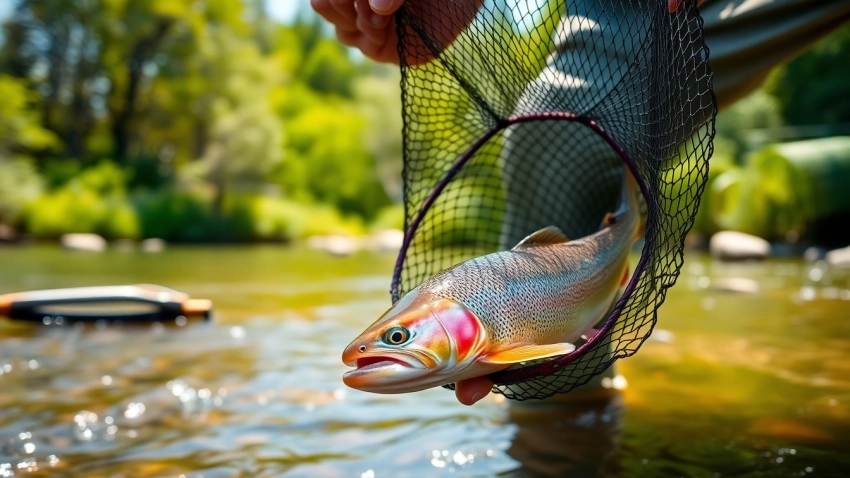
Choosing the Best Fly Fishing Net: Essential Guide for Anglers
1. Introduction to Fly Fishing Nets
In the world of angling, many tools assist in enhancing the fishing experience, with the fly fishing net standing out as an essential piece of equipment. Whether you are a seasoned fly fisherman or a novice, understanding the importance of selecting the right fly fishing net can profoundly influence your fishing success. This guide will explore the features, types, techniques, maintenance, and recommendations for fly fishing nets, ensuring you are well-equipped for your next fishing trip.
1.1 Importance of Choosing the Right Fly Fishing Net
Choosing the right fly fishing net is crucial for several reasons. Firstly, it aids in safely landing fish without causing harm. With a net that suits your fishing style and the species you target, you improve the chances of catch and release success. Furthermore, using the proper net helps in conserving aquatic ecosystems by minimizing injury to fish, which is essential for sustainable fishing practices.
1.2 Key Features to Look For in a Fly Fishing Net
When selecting a fly fishing net, consider the following features:
- Size: The length and width of the net should accommodate the size of the fish you are targeting.
- Shape: Nets come in various shapes – oval, rectangular, or round. Each has advantages depending on fishing technique and species.
- Handle: The handle length should match your fishing environment. Longer handles are ideal for wading in rivers, while shorter handles may work well from the bank.
- Mesh Type: The type of mesh influences how easily fish can be released. Rubber mesh is preferred for minimizing damage.
- Weight: A lightweight net is easier to carry around, especially on long fishing days.
1.3 Common Materials Used for Fly Fishing Nets
The materials used in fly fishing nets can impact their longevity and usability:
- Wood: Traditional and aesthetically pleasing, wooden nets are sturdy but may require more maintenance.
- Aluminum: Lightweight and corrosion-resistant, aluminum nets are durable and commonly used in various fishing conditions.
- Plastic: Affordable and easy to clean, plastic nets can be found in various styles but may not be as durable as other materials.
- Rubber Mesh: Often used in the netting, rubber mesh is gentle on fish scales and is becoming a popular choice for conservation-focused anglers.
2. Types of Fly Fishing Nets
2.1 Floating vs. Landing Fly Fishing Nets
Fly fishing nets primarily come as floating or landing nets. Floating nets are designed to remain on the water’s surface and are useful for keeping your net close while keeping fish in a natural position. Landing nets typically feature deeper bowls to cradle fish securely during the landing process, allowing for safe capture and release.
2.2 Rubber Mesh vs. Nylon Mesh Fly Fishing Nets
Two common types of net meshes are rubber and nylon. Rubber mesh nets are gentler on fish and reduce slime loss, promoting decreased stress and injury. On the other hand, nylon nets may snag fish, causing damage during release. Many modern anglers prefer rubber nets for their catch-and-release efficiency.
2.3 Compact vs. Full-Sized Fly Fishing Nets
Compact nets are ideal for backpackers and stream anglers who require portability without sacrificing quality. These nets often fold or collapse, providing easy storage. Conversely, full-sized nets offer more surface area, which is advantageous for larger fish but may be cumbersome to carry.
3. Techniques for Using a Fly Fishing Net Effectively
3.1 Best Practices for Catching and Releasing Fish
Using a fly fishing net effectively involves several best practices:
- Approach Carefully: Approach the fish as quietly as possible to avoid spooking it.
- Control the Line: Keep the line taut while guiding the fish toward the net. A relaxed line can lead to lost catches.
- Net from Behind: Gently position the net behind the fish for a smooth entry without startling it.
- Support the Fish: When lifting the fish from the water, support its body with the net to reduce stress on its fins.
- Limit Air Exposure: Keep the fish in the water as long as possible and limit the time it spends out of water during release.
3.2 Tips for Handling Your Fly Fishing Net
Proper handling of your net is essential for longevity and performance:
- Minimize Drag: Avoid dragging your net over rocky surfaces, which can damage the netting and structure.
- Rinse After Use: Rinse the net in freshwater after use to remove debris and saltwater.
- Store Properly: Store your net in a cool, dry place to prevent material degradation.
- Inspect Regularly: Regularly check the net for any tears or weak points that may compromise its effectiveness.
3.3 Common Mistakes to Avoid When Using a Fly Fishing Net
While using a fly fishing net, avoiding certain mistakes can improve your success:
- Rushing the Process: Trying to rush the landing can lead to lost fish. Patience is key.
- Ignoring Net Size: Using a net that is too small can lead to damage to the fish and complications in landing.
- Improper Release Techniques: Failing to handle fish gently or leaving them exposed to the air can increase mortality rates.
4. Maintenance and Care for Your Fly Fishing Net
4.1 Cleaning Your Fly Fishing Net
Regular cleaning extends the lifespan of your fly fishing net. After every fishing trip, rinse your net in freshwater to remove dirt and salt. For deeper cleaning, consider using a gentle soap solution, particularly if your net has accumulated oils or slime from fish. Rinse thoroughly to ensure no soap residue remains.
4.2 Storing Your Fly Fishing Net Properly
Proper storage keeps your fly fishing net in optimal condition. Avoid leaving your net in direct sunlight, as UV rays can degrade materials over time. Instead, store it in a protective sleeve or bag to prevent damage and keep it clean. Additionally, hanging or laying your net flat keeps the mesh and frame in good shape.
4.3 Inspecting Fly Fishing Nets for Damage
Before heading out, inspect your fly fishing net for any signs of wear and tear. Look for frayed mesh, bent frames, or loose handles. Regular inspections allow you to remedy any issues before they lead to lost catches on the water.
5. Choosing the Right Fly Fishing Net for Your Needs
5.1 Budget Considerations for Fly Fishing Nets
Your budget will play a significant role in determining the fly fishing net you choose. While it’s possible to find high-quality nets at any price point, investing in a more durable model can save money in the long run. Evaluate features based on how often you fish and the environments you frequent.
5.2 Customizing Your Fly Fishing Net Experience
Customizing your fly fishing net experience can enhance your fishing outings. Consider personalizing nets with grips that suit your handling style or nets that are readily compatible with accessories, such as net floats or retractor clips. Specialized nets designed for target species can make a significant difference in your catch-and-release experience.
5.3 Recommendations for Top Fly Fishing Nets
When choosing a fly fishing net, there are specific factors to keep in mind. Look for nets with good reviews concerning durability and functionality. Rubber handled nets are popular for their added grip and feel. Additionally, consider nets with extendable handles for those hard-to-reach spots or larger species. Here are a few recommended features to look out for:
- Lightweight Design: A lightweight net is often easier to maneuver during fishing, especially in flowing water.
- Quick-Dry Materials: Fast-drying nets help prevent mildew and prolong the net’s lifespan.
- Strong Frame: Ensure the frame is constructed from a material that can withstand the pressure of larger fish.







Leave a Reply